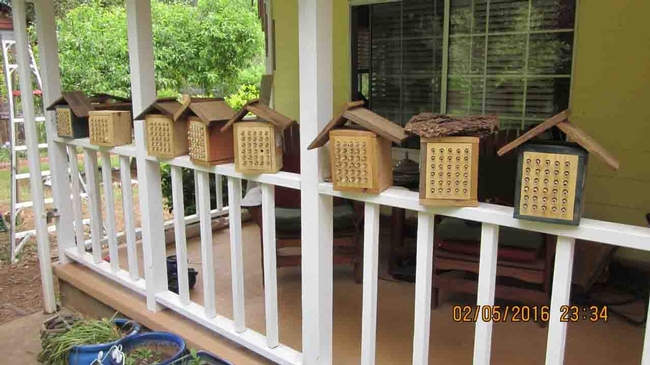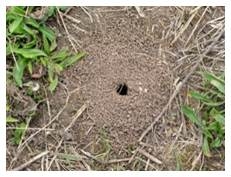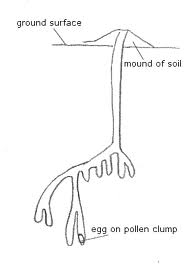It's important to protect our bee populations because their survival and reproduction provides pollination benefits for agricultural, urban, and wildland environments. This is especially evident here when we welcome commercial bees to pollinate almond orchards each spring. These almond blossoms are only the beginning of the rich agricultural smorgasbord relying on pollination from bees. Our bubble of bee knowledge is largely limited to social bees that live in colonies and are used commercially in orchards, fields, and green houses. The most well-known in the American landscape, the honeybee (Apis mellifera L.), was first introduced by European settlers along the Eastern seaboard in the early 17th century. Documentary evidence tells us it took over 200 years for the European honeybee to make its way to California.
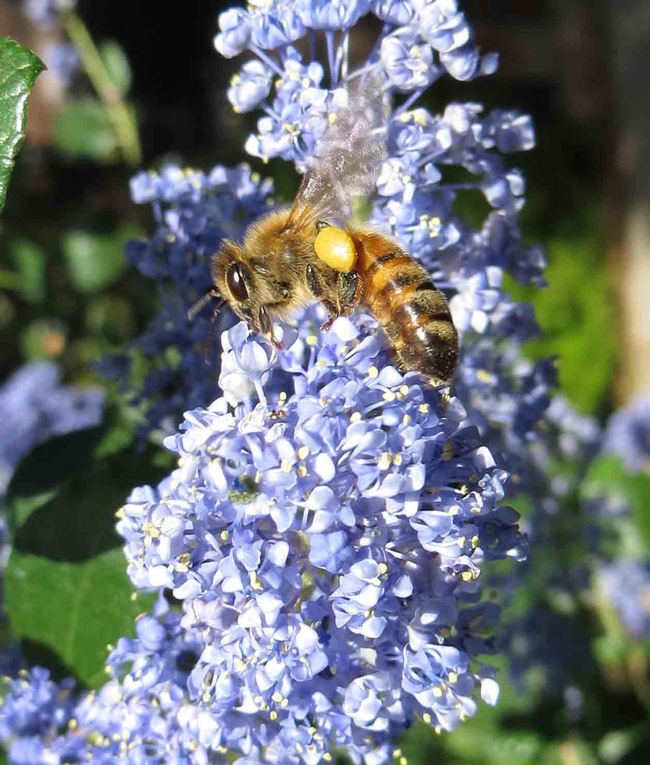
While there are over 4,000 species of bees found in North America, California is home to 1,600 native species. These natives were here prior to the arrival of European honeybees. European honeybees may have been introduced to California in 1853 from swarms purchased in Panama, carried across the Isthmus, and shipped to San Francisco. Apparently only one swarm made the arduous trip and was delivered to F. G. Appleton, a San Jose apiarist. Until this time, diverse native bee communities were the primary pollinators, filling a wide range of ecological roles throughout our state.
Native bees are actually better adapted to meet the needs of a broad diversity of flowering plants in urban, suburban, and rural areas. While one third of our food crops rely on both native bees and commercial honeybees for pollination, home gardens mostly rely on healthy native bee populations. It's been estimated that only 25 to 40 percent of native flowering plant species are pollinated by honeybees. In order to protect ecosystem resilience and diversity, we need to protect the health of our native bees.
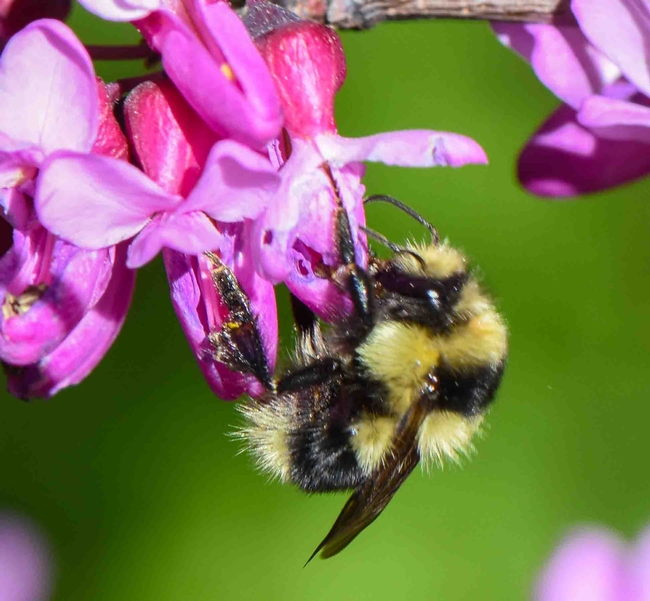
Most native bees are not aggressive and are not inclined to sting since unlike honeybees they are not protecting their hive. Males generally have no sting. Females may sting if swatted or stepped on, but they don't have enough venom for the sting to be painful. Native bees range in size from tiny to large and vary in color.
Some of the natives seen in my Paradise garden include the following:
- Carpenter bees (Xylocopa varipuncta) are social, forming a small colony that nests in wood. The female Valley carpenter bee is about an inch long black bee that resembles a bumble bee but is less hairy. The male, commonly known as "the teddy bear bee," is green-eyed and blond. Small carpenter bees (Ceratina) also tunnel into wood, are nearly hairless, and are metallic-looking. Some species sport yellow markings and can be mistaken for flies.
- Sweat bees (Halictidae)are attracted to salty sweat. This species of bee is metallic green, blue, or black with greenish-yellow markings.
- Bumble bees (Bombus). Feral honeybees and bumble bees constitute a large percentage of the bees I see daily. Like honeybees, bumble bees are social and live in small colonies, unlike the solitary native bees.
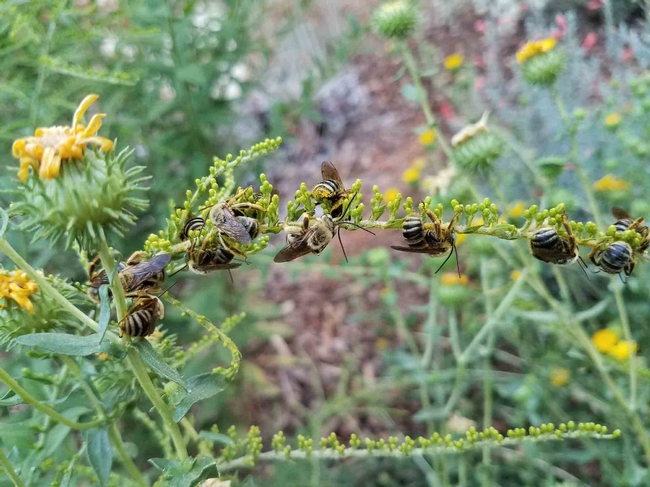
Native bees are unsung heroes. Some, such as the yellow-faced bumble bee (Bombus vosnesenskii) are better pollinators than honeybees because of their foraging behaviors and large, hairy bodies. Agricultural crop systems, as well as urban and wildland environments, benefit from native bees. The reproduction and survival of diverse species of native bees depend on all of us. Dr. Gordon Frankie, professor and research entomologist at University of California, Berkeley, recommends the following to protect our native bee populations:
- Eliminate pesticides
- Plant a diversity of nectar and pollen rich plants (ten or more species)
- Mass each plant in patches of ten square feet
- Choose plants that bloom in succession over the growing season
- Avoid excessive pruning and manicuring of ornamental flowers
- Set aside bare patches of soil for nesting
Not only will these behaviors help protect our bee populations, but they will also attract other pollinators.
Many factors contribute to declining native bee numbers: increased use of chemicals; loss of wildflower meadows and other suitable habitats; more land being developed for commercial and residential property, landscapes incorporating more hardscape and fewer pollen-producing plants. Plus, homeowners are quick to call pest control companies to eradicate unwanted bugs rather than try to implement Integrated Pest Management (IPM) methods. The solution to turning around the declining health of native bees is to act individually and proactively, as well as to raise awareness. Here are some steps we can take:
- Support local nurseries that sell plants and seeds that haven't been treated with neonicotinoids, a class of pesticides commonly used as seed treatments (NSTs) and systemic sprays in greenhouses.
- Buy organic vegetable seeds or packs.
- Ask if in doubt about a particular plant you're interested in purchasing. The same applies to food. Supporting local farmers markets helps promote sustainable agriculture, and may help keep harmful pesticides out of the soil and water. Many of the venders at farmers markets do not use neonicotinoids when growing their fruits, flowers, and vegetables. And they are right there at the market to talk about their farming practices.
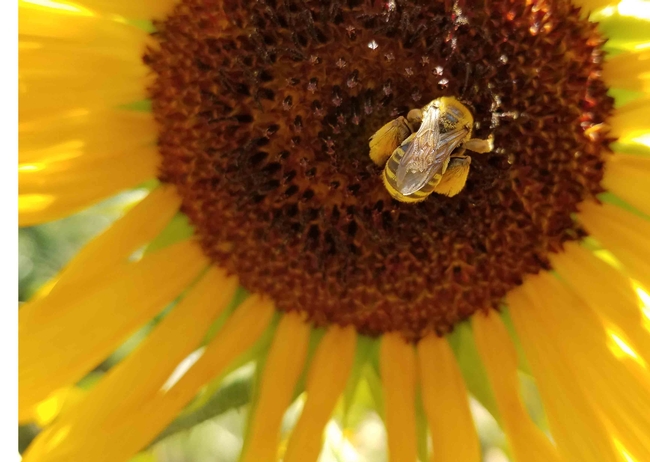
Learning to manage your pests through IPM tactics will also help minimize adverse effects on declining bee populations. The University of California's IPM website provides scientific, location-specific pest control information for homeowners. Homes become less toxic to pets and children when their play areas are not treated with pesticides. Homeowners can share what's working in their gardens with neighbors and friends, which may help eliminate pesticides in other yards and gardens.
Providing food, shelter, and nesting areas for wildlife in the garden will also help our native bees. Pollen is protein for bees and nectar is their carbohydrate, providing energy and maintaining water balance in their diet. Plant a variety of annuals and perennials in the garden for bees to enjoy. Provide water sources. A shallow dish filled with pebbles and water will not only provide bees with a drinking station but will help other beneficial insects as well.
It is vital that our bee populations are protected. Their survival and reproduction provide pollination benefits that sustain our planet. While native bees go unnoticed, learning more about them and protecting their natural habitats will help assist these prolific pollinators and insure our own well-being.
To learn more about bees, investigate the following sources:
- The Xerces Society
- The UCANR publication, Native Bees are a Rich Resource in Urban California Gardens
- The Pollinator Partnership
- The UC Berkeley Urban Bee Lab
- Real Dirt article by Cindy Weiner, “Bumble Bees in the Garden
Information in this article has been derived from:
- California Native Plant Society, Small Wonders: The Plight and Promise of California's Native Bees by Emily Underwood, June 24, 2021Ecosphere, volume 11 issue 2 February 2020
- Ecosphere, volume 11 issue 2 February 2020, Dara A. Stanley, Simangele M. Msweli, Steven D. Johnson, Native honeybees as flower visitors and pollinators in wild plant communities in a biodiversity hotspot
- Kellar, Brenda, Honey Bees Across America
UC Master Gardeners of Butte County are part of the University of California Cooperative Extension (UCCE) system. To learn more about us and our upcoming events, and for help with gardening in our area, visit our website. If you have a gardening question or problem, email the Hotline at mgbutte@ucanr.edu (preferred) or call (530) 538-7201.
Attached Images:
